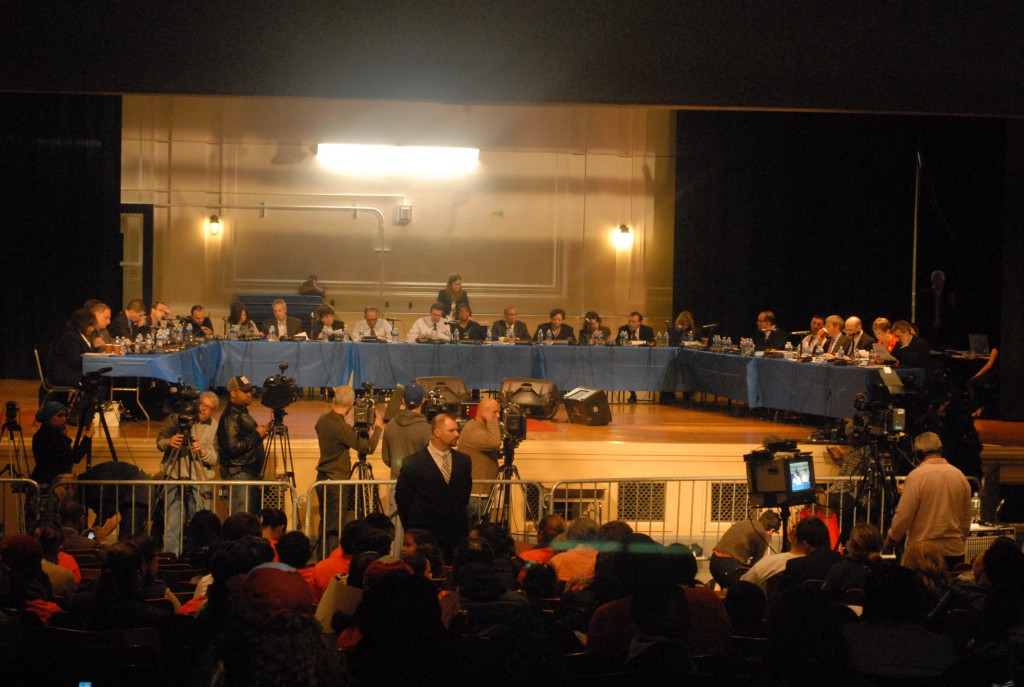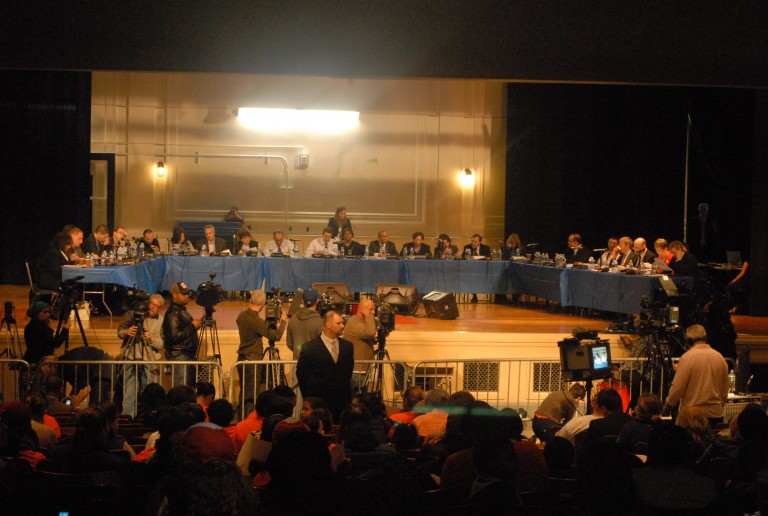
Media and the public crowded around the stage where the Panel for Educational Policy voted 8-4 to close down 24 schools and immediately replace them with new schools. Forum Newsgroup Photo by Jeremiah Dobruck.
As part ofthe controversial turnaround plan, the Panel for Educational Policy (PEP) voted eight to four on Thursday, April 26 to close 24 schools across the city, including seven in Queens.
The 24 schools will cease to exist in the fall, and a new school will be opened in each building with new leadership, new PTAs and the same students.
A committee, including a new principal, Department of Education (DOE) representatives and teachers union representatives will then hire a faculty for the new school.
The turnaround plan is one of four plans handed down by the federal government that schools could follow to receive millions of dollars in grant funding.
The 33 eligible schools across the city were ones designated “persistently low achieving” based off of progress reports and comparisons to similar schools by the DOE.
In the weeks before the vote, teachers and students at packedout public hearings at each school lambasted the plan.
On Thursday, the half-full auditorium at Prospect Heights High School in Brooklyn also produced dozens of speakers opposing the initiative.
“What is going on in this city is insane,” said Brooklyn Councilman Jumaane Williams.
He was one of about half a dozen politicians to chastise the panel for their action.
He carried a common theme in many of the speakers, saying the DOE did not properly support these schools and is now punishing teachers and students for their failures.
“Opening and closing schools takes no creativity,” he said. “You guys and the mayor are on the wrong side of history.”
After hours of testimony hurled from angry students and teachers, the PEP voted to pass the plan just before midnight.
The PEP appointees from Queens, the Bronx, Brooklyn and Manhattan objected to each closure. The mayoral appointees on the panel all voted in favor of the plan.
“Puppets” the dwindling crowd shouted each time the PEP voted to close a school.
Deputy Schools Chancellor Marc Sternberg said this is a chance to completely scrap each school and rebuild it—eliminating its weaknesses and keeping all it strengths.
Dmytro Fedkowskyj, the Queens representative on the PEP, tried to stop the plan with a simple question: Why now?
About six months ago, the DOE had advocated putting each underachieving school into less disruptive models also allowed under the federal plan.
They were supposed to have years to implement a more gradual reform.
When Mayor Michael Bloomberg announced in his State of the City address in January that each school would now use the turnaround plan, educators felt blindsided.
“This is administrative insanity,” said Rosemary Wildeman, a counselor at Richmond Hill High School for eight years.
She said she decided to work past retirement age to provide a familiar face for students at the school, which has a high percentage of transfer and English-language-learning students.
“I just feel this is so wrong,” she said. “These students need stability.” Because of the vote, all teachers at the 24 schools will have to reapply for their jobs or remain in a pool of teachers without an assignment who still receive a paycheck.
According to the regulations for the turnaround plan handed down by the federal government, the school must be closed and reconstituted under a new name.
Additionally, no more than 50 percent of the teachers at the closed school can be rehired at the new school.
But according to the city’s agreement with the United Federation of Teachers (UFT) no less than 50 percent of the teachers at the closed school can be rehired at the new school.
However, Sternberg said the DOE is not holding the hiring panel to that hard 50 percent return rate.
The DOE has instructed principals and the hiring committee to put together the best educators it can for the new schools, even if that means breaking the federal guideline.
Sternberg said before the vote that he believes this still follows the spirit of the rule and it will be up to the state—which is holding the grant money—to award the funding.
“The federal guidance offers some flexibility, and that’s ultimately up to the state to arbitrate,” said Sternberg. Fedkowskyj, however, objected to this. He said this plan puts an undue burden on principals to choose between the best teachers and the possibility of not receiving that federal money.
Schools Chancellor Dennis Walcott said that doesn’t matter.
“I’ve been clear in saying the dollar isn’t the ultimate goal,” he said. “To me, this is a great opportunity for a school to reunify itself with a new mission.”
He also said the DOE’s focus now needs to be preparing schools and principals to reform and rebuild PTAs, school leadership teams, curriculums, learning communities and more before the new schools open in September.
Last year, the PEP originally voted to put all 33 eligible schools into less drastic models that did not close the schools but were still approved to claim the funding.
“If this model was so good, we would’ve done it last year. We didn’t,” said Fedkowskyj.
The turnaround model has also become a symbol of friction between the Bloomberg administration and the United Federation of Teachers.
Adding to this, the state had tied the grant funding to school districts implementing a teacher evaluation system.
When Bloomberg introduced the plan, his negotiators and the union had walked away from the bargaining table where they were working on that system.
Bloomberg argued the firing and rehiring of teachers counts as a de-facto evaluation system and would be enough to claim the funding.
The DOE did not discuss this at the PEP vote and never gave an answer that satisfied all the PEP members about why the turnaround is the best option now but wasn’t during the original vote.
“I still haven’t gotten an answer,” Fedkowskyj said. “Why didn’t we do this six
months ago?”
After the vote, the few remaining teachers in the room let their frustration bubble up as they filed out and the PEP continued with other business.
“How does it feel to hurt children and the people who care about them,” one shouted.
Richmond Hill High School, John Adams High School in Ozone Park, Newtown High School in Elmhurst, Flushing High School, August Martin High School in Jamaica, William Cullen Bryant High School and Long Island City High School are the Queens schools slated for closure.
By Jeremiah Dobruck
j.dobruck@theforumnewsgroup.com

